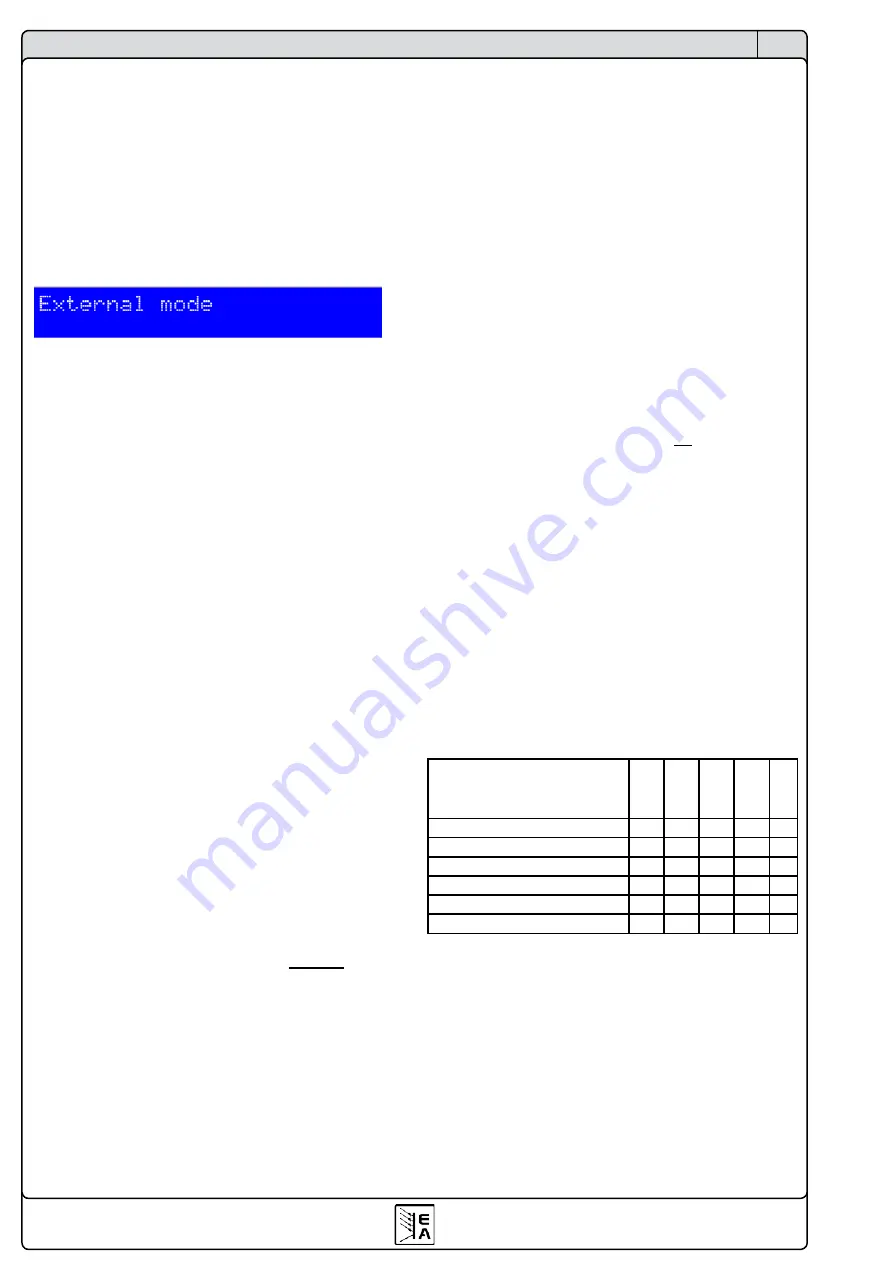
42
EN
Instruction Manual
EL 9000 HP Series
Date: 05-31-2011
Handling the device
8. The analogue interface
Introduction
The analogue interface is a 15pole Sub-D socket and is
located at the rear side. It is designed to remotely control
the most important functions of the electronic load by
external hardware (eg. SPS, switches, relays) with it.
The load requires to be switched to external control
in order to use the analogue interface. This is done
by connecting Pin 7 (Remote) with ground (Pin 6) by
a jumper or switch.
The status is then displayed like this:
Switching to external control can be done in any situation
(except setup menu active). Eventually active remote con-
trol or a running battery test are aborted and the control
location is set to „local“.
Priorities
The analogue interface has priority over any other ope-
ration mode. Hereby the set value inputs are activated
and the set values for the load can only be adjusted from
external by means of an external voltage source (PLC,
0...10V application) or potentiometers. See table „8.4 Pin
assignment of the analogue interface“) for an overview of
the inputs. Additionally, the control via the interface card
is blocked in this mode, but actual values can be read
with it (i.e. monitoring).
8.1 Important notes
For details also see „8.4 Pin assignment of the analogue
Caution! The inputs are not protected against overvolta-
ges. Higher voltage than specified in section
8.4 on any
input of the analogue interface may damage the device!
Please read and follow these instructions carefully:
•
before connecting the hardware (with a Sub-D plug)
which is used to control the analogue interface, wire
all necessary connections and check the hardware
for not supplying >10V respectively not more than the
specified value.
•
the constant resistance regulation requires all four set
values (U, I, P, R) to be fed in, if it‘s not used three set
values (U, I und P) are sufficient.
•
if the constant resistance regulation is not used, it needs
to be deactivated by putting a jumper from Pin 12 (R-
active) to Pin 6 (DGND):
Pin 12 = Low = Resistance regulation inactive
Pin 12 = High = Resistance regulation active
•
if resistance regulation is used, you can select the
resistance range before or while using the analogue
interface. Pin 13 (R-Range) is used to switch between
the two ranges:
Pin 13 = Low =Resistance range 2 is used
Pin 13 = High = Resistance range 1 is used (default)
•
the input Rem-SB (Remote Standby, Pin 8) overlays the
pushbutton
Input on/off(4)
. That means, that you can
switch the load input off or on with this pin at any time
(even if the load was not set to external control via the
analogue interface) and as long as this pin is tied to 0V
(ground) the load input will be permanently off and can
not be set to on with the pushbutton
Input on/off(4)
or
via remote control by an interface card.
•
the output VREF can be used to generate set values for
the set value inputs VSEL, CSEL, PSEL and RSEL. For
example: in case that only CC regulation is required,
the set value input VSEL has to be tied to 0V, PSEL
to VREF and CSEL can either be fed from an external
0...10V source or via a potentiometer (GND and VREF,
slider to CSEL). See also the table below.
•
adjustable rise/fall times and pulse widths like in the
Level A/B
mode are not effective here. If a certain form
of amplitude-time-progression is favoured, it has to be
generated by an external function generator and fed in.
•
the trigger input (Trigger In) has no function when
controlling the load via analogue interface (
External
mode
). That means that set value leaps have to be
generated with the signal that is fed in to the set value
inputs.
8.2 Example configurations
The table below shows example configurations for va-
rious single or combined regulation modes.
It always
applies, that pin 7 (Remote) always has to be pulled
to 0V (DGnd) and pin 12 (R-Active) too, if resistance
regulation is not used.
Explanation: it is not necessarily required to give a fixed
10V to any non-variable input. It can of course also be
a lower voltage in order to limit, for example, the power.
Best to tie the non-variable inputs to VREF respectively
to GND, if required.
Pin
VSEL
CSEL
PSEL
RSEL
R-active
Voltage regulation (CV)
var. 10V 10V -
L
Current regulation (CC)
0V var. 10V -
L
Power regulation (CP)
0V 10V var.
-
L
Resistance regulation (CR)
0V 10V 10V var. H
Current & power (CC+CP)
0V var. var. -
L
Current & resistance (CC+CR) 0V var. 10V var. H
„var.“ = variable set value of 0...10V, which can be, of course, pulsed
in order to emulate the
Level A/B
operation.
„H/L“ = High or Low, for level see table8.4
Figure 15
Summary of Contents for 33200246
Page 2: ......
Page 7: ...7 CN EL 9000 HP 系列 产品说明书 日期 05 31 2011 关于产品 3 外观 3 1 前视图 图 1 ...
Page 8: ...8 CN EL 9000 HP 系列 产品说明书 日期 05 31 2011 关于产品 3 2 后视图 图 2 ...
Page 24: ......





































